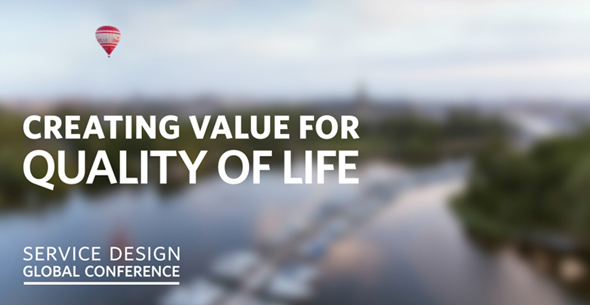Videos online of Service Design Global Conference 2014

On 7-8 October around 650 global thought leaders and practitioners from sectors such as hospitality, insurance, retail, telecommunications, finance, IT and healthcare gathered in Stockholm for the 7th Service Design Global Conference.
Coming from 40+ countries, they gathered to share the latest thinking, trends and best practices to empower change through Service Design.
The videos of the keynote talks are now online:
A world where we can belong anywhere [31:15]
Mark Levy, Global Head of Employee Experience, Airbnb
Mark focused on employee engagement as well as how his team is working with Service Design to bring together the global community of employees, hosts and guests. Mark’s keynote shared some key lessons how employee experience enables great customer experience for both hosts and guests. He inspired us to see how new services can create value and improve lives, in a world where we all can belong anywhere.
Little things make the biggest difference [21:31]
Stan Phelps, founder, 9 INCH marketing
His talk featured lessons from the Amazon Best Seller, What’s Your Purple Goldfish”. It covered the ingredients of creating value and the 12 different types of little extras. Little things that add value and make life easier for customers. The presentation featured customer-centric marketing lessons from leading brands such as Apple, Disney, Southwest and Zappos. Attendees could learn about differentiation, the importance of service design and its impact on loyalty and word of mouth.
There are things in life you can’t design [15:31]
Tenzin Shenyen, Tibetan Buddhist monk
His talk presented a Buddhist take on design, arguing that karma and experience cannot even be correlated for predictable effect, much less be designed. The task of designers today is to just ride the chaos and make decisions characterised by innocence and precision. From cinema directors to kamikaze pilots, from biographeme to biography and back again, Shenyen traced a soft logic lineage of ‘contemporaries across millennia™.
Design that serves
Kigge Hvid, CEO, Index: Design to Improve Life [20:16]
From the outset of the biggest design award in the world — INDEX: Award – which receives nomination from over 80 countries around the world, Kigge showed how the design of services can improve life for people and why the world does presently not need any more white teacups.
A Nordic model of service design [22:38]
Lavrans Løvlie, Director, Livework
“The Nordic Model” is a term used to describe how the robust Nordic economies have managed a successful balance of power between people, business and the state. As Service Design grows up from being a method to design for customers to become a powerful tool for business and government, designers face the same balancing act. Lavrans talked about the future of Service Design through the lens of the Nordic Model, and gave examples of the impact design can make for customers, when balanced with the realities of an organisation and the drive for business value.
Scratching beyond the cultural surface of service design [38:47]
Low Cheaw Hwei, Global Head of Product and Service Design, Philips Design
Service is age-old, how does putting a design prefix make it a new discipline? What did we miss, discover and learn so far?
Societal challenges as an engine for business innovation [20:55]
Malin Orebäck, Director Design Strategy, Veryday
In many companies and public sector organisations we tend to see social challenges as obstacles that will cost money. This talk connected the “Shared Value Approach”, initially developed by Michael E. Porter and Mark R. Kramer, with Service Design Thinking to provide a framework for using these challenges to the benefit of all the players in the entire value chain. As innovators and change leaders we have an opportunity to improve quality of life through building shared value and as professionals in the Service Design field we are all uniquely positioned to make it happen.
Redefining value, to business and to society [25:30]
Nathan Shedroff, Chair, MBA in Design Strategy, California College of the Arts
All value only emerges in the context of a relationship and the best value lies beyond the qualitative kinds taught to businesspeople (like price and performance). The opportunity to create the most and best value, over the long term, requires us to understand qualitative issues that drive decisions, meaning, and satisfaction. In this way, service design can strategically drive value in businesses (and even NGOs).
How to establish service design as a driver of business [24:30]
Fred Leichter, designer, Fidelity Investments
Fred Leichter spent the last year as a Fellow at the Stanford University d.school immersing himself in Design Thinking and working on developing projects to meet the needs of our increasingly aging society. The talk has the subtitle “Empathy for an aging world.”
Social design = Better design? [25:54]
Denis Weil, Designer-in-Residence, Sanergy
The Design community and particularly Design Education has geared up to enter the Social space. However today this is more “Push than Pull” with more supply and interest from designers and educators than from NGO’s and social enterprises. In order to change that we designers need to both adapt our practices and our business models. In this perspective he shared learnings from his current personal transition into social innovation and made a case for social design not necessarily being better for society or the designer’s soul but rather serving as a new and better model for design, particularly service design.
The realities of health and wellness innovation
Alisan Atvur, Director, Atvur Innovation and
yron Wilson, Idea Manager, Southern California Internal Innovation Group, Kaiser Permanente
Societal change doesn’t happen through service design alone: it happens when people use a real-world, tactical approach for changing an organization’s behavior. In this presentation, Alisan and Byron explored the tactics of making an organization more service minded. This talk shed light on the methods used to overcome some of the organizational dynamics that burden service innovation. Filled with real anecdotes and tactics for overcoming challenges, the talk described how even the most difficult environment can be more creative, strategic and human-centered.
Impacting quality of life with enterprise IT [16:08]
Marion Fröhlich & Mauro Rego, Design & Co-Innovation Center, SAP
Typically, enterprise software is primarily intended to achieve some functional objective: to track, store or manage business data or to support related process using that data. The impact of enterprise software is often narrow and limited only to what it can accomplish in a specific business context. Nevertheless, it has a bigger- and often unforeseen – potential to impact quality of life. In this talk, Marion and Mauro shared how well-conceived design can have an impact beyond its primary business goals. By creating real value for different roles, beyond the scope of the initial functional requirements, enterprise software can affect people’s lives differently.
Bridging the gap between intent and execution [23:41]
Richard Newland, Managing Director, Customer Expertise
In todays connected word, customers are in touch with many channels when they do business with us. How do we drive change in our organisations to ensure that we give our customers a seamless and a brilliant experience, that improves their quality of life? How do we create value across physical and digital spaces to be relevant and to create a real competitive advantage in this rapidly changing market environment? Believing you have the right strategy and the intention to drive up these standards is just stage one of the process, how do you take these theories and execute it effectively in your business, while ensuring you deliver a commercial return as well as giving you a customer experience edge over the competition.
Entrepreneurship in pursuit of happiness [27:15]
Stefan Krook, CEO, Kivra
Profits are to businesses are like air to us humans. Necessary for survival. But just like we do not live in order to breath, businesses do not (have to) exist in order to make profit. Stefan told his own story of why he decided to dedicate his life to entrepreneurship in order to do good. He shared insights and his business model for several successful GoodCause companies he had founded and developed over the last 10 years. He also let the audience in on the gigantic service design challenge of replacing postal mail with a secure digital postal service. A challenge clearly aiming at creating value for quality of life.
What can design bring to government? [25:20]
Andrea Siodmok, Head, UK Policy Lab
The UK’s Policy Lab was launched at the beginning of April 2014. Policy Lab is a creative space where civil servants can experiment with new techniques and approaches to policy problems from data science to design. Its existence is born of a recognition that government needs to get better at policy-making; open it up, make it quicker, more digital and more connected with the people who are affected by it. In this session Andrea shared their projects and revealed how they are working with design ethnographers, data scientists and other experts to develop new ideas in Government.
Just build it! [26:47]
Meggie Williams, lecturer, Industrial Design Engineering/Open Innovator program, The Hague University of Applied Sciences
An encouragement to develop and spread the practice of simple model building in the early phases of service design projects. Building simple models helps to rise above mere conceptual thinking. Both detailing and embodiment stimulate the design process. Also “Building it” can play a role in developing the craftsmanship of the service design profession. Simple models communicate better than words because their “unfinishedness” invites discussion and alteration. Great both for user testing and engaging business partners.
Change by service design? No way! [23:24]
Wim Rampen, Manager of Intelligence and Brands of Delta Lloyd & OHRA, Delta Lloyd Group
Most successes in business are presented as if they’re a clear result of good thinking, planning and execution. By (Service) Design some might say. Wim thinks reality is exactly the opposite. Success, progress and transformation even, are messy processes that are mostly a result of chance and luck. So what can you do to still drive the change you want? He presented five strategies to increase your luck of being successful.
Passionate leadership and engaged employees [24:47]
Mia Kleregård, Head of Service, Systembolaget
Systembolaget is a state owned company that have monopoly to sell alcoholic beverages in Sweden. It has a mandate from the government with a clear vision “A society in which everyone can enjoy alcoholic drinks with due regards for health considerations and without harming themselves or others. This means that 5 000 employees are selling alcohol from special shops and under Swedish alcohol law restrictions. During the biggest change of the company they went from the typical state owned company that was not too popular to receive multiple rewards for “Best in Service”. Their journey has been amazing and was done in three years, the Swedish people support has never been so good.
They choose to develop their service throughout leadership training with a clear intention on “becoming the best I can be. Only to realize that not only did the meaning of work change, even the value of life changed. Passionate leadership that involves and engage employees to become “the best they can be: was their key.
How they did it? Mia inspired the audience sharing some key takeaways. Welcome to a presentation in true inspiration on how to create value for life and your employees.
Design as an agent for change in complex systems [27:11]
Lorna Ross, Director of Service Design, Mayo Clinic Center for Innovation
Mayo Clinic is the pioneer in the healthcare arena, being the first medical community globally to leverage the service and experience design competency actively.
Lorna showcased projects and case studies and shared general insights and lessons learned. She also touched on how the discipline of service design has evolved to adapt to clinical context, and how creativity and imagination gain credibility in evidence-based culture.



